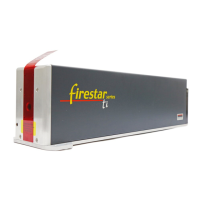technical reference
32 Synrad Firestar ti-Series operator’s manual
Technical overview
The Technical overview section includes subsections:
■ ti-Series laser
■ Optical setup
ti-Series laser
Laser tube
Firestar
®
ti-Series lasers were developed using new technology patented by SYNRAD, Inc. Firestar’s
patented “t” technology, based on a combination of free-space and waveguide resonator designs, enables
SYNRAD to economically produce a symmetrical laser beam from a small but powerful laser capable of
operating for many years with virtually no maintenance. Firestar’s unique extruded aluminum envelope
offers excellent heat transfer, long gas life, and low operating costs in contrast to other laser tube technolo-
gies. In addition to being the vessel that maintains the lasing environment, the aluminum tube is also the
structural platform that integrates the laser’s optical, electrical, and cooling components.
Optical resonator
The optical resonator, in conjunction with the electrodes and the gas mixture, generates the laser beam.
Firestar ti-Series optical resonators are comprised of three optical elements: a front mirror, a rear mirror,
and an output window. These optical elements are fastened to the tube’s exterior and are exposed to its in-
terior through holes in the end caps. O-rings are sandwiched between optical elements and the end cap to
form a gas seal and to provide a flexible cushion that allows the slight movement necessary for alignment.
All optical elements are aligned and locked into place by factory technicians before the laser is shipped.
The output beam, roughly circular as it exits the resonator, transitions to a Gaussian-like mode in five to
ten Raleigh ranges (1.6–3.3 m). The internal structure and optics of the resonator combine to produce a
Gaussian-like mode quality (M
2
factor) of < 1.2. As shown in Figure 3-1, beam waist diameter is 2.2 mm
at the output aperture and full angle divergence due to diffraction is less than 7 milliradians (a 7 mrad full
angle divergence means that beam diameter increases 7 mm over every one meter distance traveled).
Caution
possible
equipment
damage
Because of their smaller beam diameter, Firestar lasers have signifi-
cantly higher power densities than previous SYNRAD lasers. This
means that even small amounts of contaminants on the laser’s output
coupler (or on any beam delivery optic) can absorb enough energy to
damage one or more optics in the beam path. Periodically inspect the
laser’s output coupler and all other beam delivery optics for signs of
contaminants, and then carefully clean as required. In dirty environ-
ments, purge laser optics using filtered air or nitrogen to prevent
vapor and debris from accumulating on optical surfaces.

